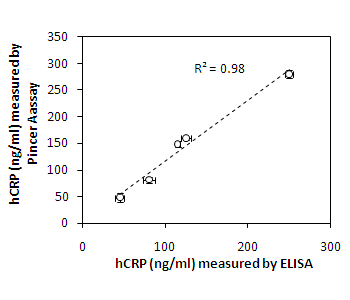FRET-PINCER® Assay
Patented FRET-PINCER® Assay Platform
The patent-protected FRET-PINCER Assay system detects the concentration of the target molecule by bringing together complementary single-stranded DNAs and their attached fluorophores to produce fluorescent light through FRET (fluorescence resonance energy transfer).
Two PINCERs recognize epitopes of the target protein in a specific antibody-to-antigen binding association. The antibodies are chemically linked through a flexible linker to dsDNA fragments with short complementary ssDNA overhangs. These overhangs provide some propensity for the two DNA fragments to associate; however, in the absence of the target protein, very little association between the DNA fragments occurs. In the presence of the target protein, binding of the target protein by the PINCERs will drive the association of the complementary single-stranded DNA overhangs to form a dsDNA duplex. The tight and stable association of the dsDNA duplex brings together fluorophores that are capable of fluorescence resonance energy transfer. Therefore, concentration of the target protein is detected as a change in the level of fluorescent energy, or light, which is emitted from the assay sample.

Comparison between FRET-PINCER® assay and ELISA (hCRP target molecule)

Comparison of the hCRP serum spiked samples measured by ELISA vs. FRET-PINCER® assay

Mediomics’ PINCER® assay uses antibody binding specificity combined with DNA base-pair recognition to create a user-friendly and reproducible assay system. From sample preparation to data analysis and presentation, our PINCER® Assay kits are simple and easy to follow.
Features of the FRET-PINCER® Assay System
- Simple. Mix test sample or standard with the Assay solution and incubate at room temperature
- Fast. Read fluorescent signal after 30 minutes of incubation
- Broad Detection Range. Direct testing of samples without a dilution step.
- Flexible. Assay is compatible with most fluorescence plate readers
High-Throughput Screening Compatible
PINCER® products have been developed with support, in part, from the National Institutes of Health, through STTR Phase I and Phase II Grants.
